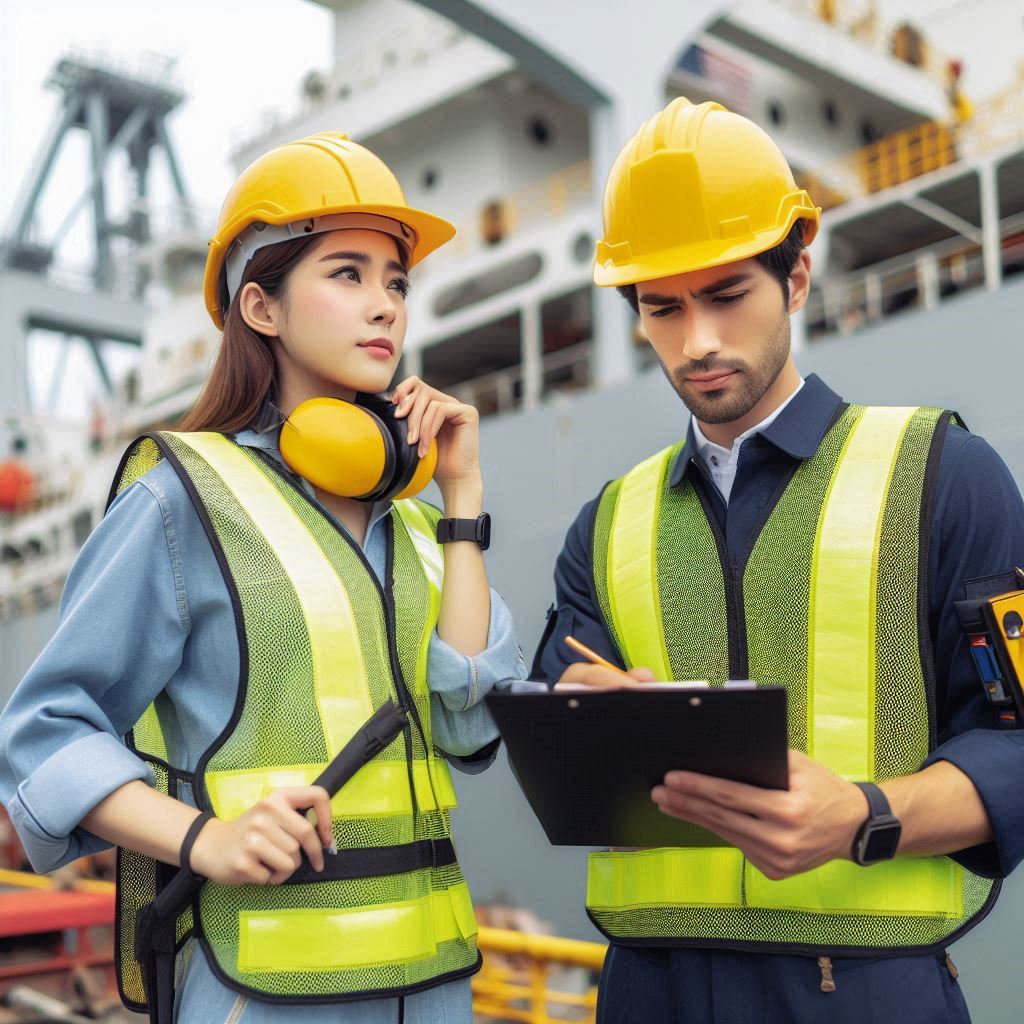Introduction
Marine engineering safety is a crucial aspect of ensuring the well-being of vessels, their crews, and cargo.
It involves maintaining and operating marine equipment and systems to prevent accidents and failures.
Effective marine engineering safety practices are essential for the smooth functioning of maritime operations and protecting lives at sea.
In the maritime industry, marine engineering safety plays a vital role in preventing disasters and ensuring compliance with international regulations.
Proper safety measures help avoid costly accidents, minimize environmental impact, and safeguard the health and safety of the crew and passengers.
By prioritizing safety, marine engineers contribute to the overall efficiency and reliability of maritime transport.
This blog will delve into best practices for enhancing marine engineering safety.
We will discuss the importance of regular maintenance and inspections, which are fundamental to identifying and addressing potential issues before they escalate.
You will gain insights into key components that should be included in maintenance checklists to ensure comprehensive evaluations of equipment and systems.
Additionally, we will offer practical tips on how to effectively conduct maintenance and inspections.
These tips will cover strategies for developing detailed checklists, scheduling routine tasks, and documenting inspection results.
Importance of Safety Training for Marine Engineers
Significance of Safety Training for Marine Engineers
Safety training is vital for marine engineers to ensure their well-being and operational efficiency.
Proper training equips engineers with the skills to handle emergencies effectively.
It minimizes the risk of accidents and injuries by educating engineers on best practices.
Regular safety training updates engineers on new regulations and technologies.
It fosters a safety-conscious culture onboard, enhancing overall vessel safety.
Engineers who undergo rigorous safety training can respond quickly to unforeseen situations.
Training also helps in maintaining compliance with international safety standards.
Key Topics That Should Be Covered in Safety Training Programs
Effective safety training programs for marine engineers should cover several key topics.
Fire safety and firefighting techniques are crucial, as fires are a common hazard on vessels.
First aid and medical emergencies training prepare engineers to handle injuries or health issues onboard.
Emergency evacuation procedures are essential to ensure safe and efficient evacuation in crises.
Hazardous materials handling includes training on managing and disposing of chemicals safely.
Personal protective equipment (PPE) usage teaches engineers to use and maintain safety gear properly.
Ship stability and damage control cover procedures to manage and correct vessel stability issues.
Safety management systems should be discussed to help engineers understand and implement safety protocols.
Additionally, training should address the use of safety equipment and emergency response coordination.
Examples of Common Safety Hazards That Marine Engineers May Encounter
Marine engineers face various safety hazards in their daily work.
Fire hazards are significant due to the presence of flammable materials and high-temperature equipment.
Electrical hazards can arise from faulty wiring or equipment malfunctions, posing risks of electrocution.
Chemical hazards include exposure to harmful substances like fuel, oils, and cleaning agents.
Confined spaces on ships can lead to dangerous situations if not properly managed, including lack of oxygen or exposure to toxic gases.
Heavy machinery and moving parts present physical hazards that can cause injuries if not handled correctly.
Slips, trips, and falls are common due to wet or uneven surfaces onboard.
Working at heights or in unstable conditions can lead to falls or accidents.
Ensuring safety protocols are followed helps mitigate these risks.
In general, safety training for marine engineers is crucial for preventing accidents and ensuring effective emergency responses.
Training programs should cover fire safety, first aid, evacuation procedures, hazardous materials handling, PPE usage, ship stability, and safety management.
Common hazards include fire, electrical issues, chemical exposure, confined spaces, heavy machinery, slips, and falls.
By addressing these areas, marine engineers can enhance their safety and contribute to a safer working environment.
Read: Tips for Writing Environmental Engineering Reports
Regular Maintenance and Inspections of Vessels
Importance of Regular Maintenance and Inspections for Ensuring Vessel Safety
Regular maintenance and inspections are crucial for ensuring vessel safety.
They help identify potential issues before they become critical problems.
Routine checks prevent equipment failures and accidents, enhancing overall safety onboard.
Regular upkeep extends the lifespan of equipment and ensures compliance with safety regulations.
Without consistent maintenance, small problems can escalate into significant hazards.
Scheduled inspections provide opportunities to address wear and tear, preventing costly repairs or accidents.
Maintaining equipment reliability is essential for smooth vessel operations and crew safety.
Key Components That Should Be Included in Maintenance and Inspection Checklists
Effective maintenance and inspection checklists should cover several key components.
Engine systems require regular checks for performance and oil levels.
Electrical systems should be inspected for wiring integrity and functionality.
Hull inspections are necessary to identify damage or corrosion.
Safety equipment, including lifeboats and fire extinguishers, must be verified for readiness.
Navigation equipment needs calibration and operational checks.
Plumbing and bilge systems should be assessed for leaks and functionality.
Regular checks on emergency equipment, such as alarms and communication systems, ensure they are operational.
Documentation of all maintenance and inspection activities is crucial for tracking and compliance.
Tips on How to Effectively Conduct Maintenance and Inspections
To effectively conduct maintenance and inspections, follow these tips.
Develop a detailed maintenance schedule that aligns with manufacturer recommendations and regulatory requirements.
Train crew members on proper inspection techniques and maintenance procedures.
Use standardized checklists to ensure that all critical components are evaluated.
Document every inspection and maintenance activity thoroughly, noting any issues and actions taken.
Prioritize tasks based on risk assessment to address the most critical issues first.
Perform maintenance and inspections during scheduled downtimes to avoid operational disruptions.
Utilize technology, such as maintenance management software, to streamline scheduling and record-keeping.
Regularly review and update maintenance procedures to incorporate new equipment or address emerging safety concerns.
Engage in continuous improvement by analyzing inspection data to identify trends or recurring issues.
Generally, regular maintenance and inspections are essential for vessel safety.
Key components of checklists include engine systems, electrical systems, hull integrity, and safety equipment.
Effective maintenance and inspection involve developing detailed schedules, using standardized checklists, and thoroughly documenting activities.
Prioritizing tasks and utilizing technology can enhance efficiency and safety.
Maintaining rigorous standards in these practices ensures reliable vessel operations and protects both the crew and the ship.
Read: Environmental Engineers in the Mining Industry
Utilization of Safety Equipment and PPE
When it comes to marine engineering safety, one of the most critical aspects is the utilization of safety equipment and personal protective equipment (PPE).
Ensuring that these tools are properly used and maintained can prevent accidents and protect the lives of crew members on board.
In this section, we will highlight the importance of using safety equipment and PPE in marine engineering, list essential items that should be readily available, and provide recommendations on how to properly use and maintain them.
Importance of Using Safety Equipment and PPE
Using safety equipment and PPE in marine engineering is crucial for the protection of crew members and the prevention of accidents.
By wearing the appropriate gear, individuals can minimize the risks associated with working in hazardous environments at sea.
PPE such as helmets, gloves, goggles, and safety shoes can provide a barrier against potential injury from falling objects, harmful substances, or slippery surfaces.
In emergencies, safety equipment like life jackets, life rafts, and fire extinguishers can save lives and mitigate the impact of unforeseen incidents onboard.
Therefore, it is imperative that all crew members prioritize the proper use of safety equipment and PPE at all times.
Essential Safety Equipment and PPE On Board
- Helmets
- Gloves
- Goggles
- Safety shoes
- Life jackets
- Life rafts
- Fire extinguishers
Recommendations for Proper Use and Maintenance
Proper usage and maintenance of safety equipment and PPE are essential to ensure their effectiveness when needed.
Here are some recommendations to follow:
- Regularly inspect all safety equipment and PPE to ensure they are in good working condition.
- Replace any damaged or expired items promptly to maintain their functionality.
- Provide training to crew members on the proper use of safety equipment and PPE.
- Store safety equipment and PPE in designated locations that are easily accessible in case of an emergency.
- Follow manufacturer’s instructions for cleaning, storing, and maintaining safety equipment and PPE.
- Conduct regular drills and exercises to practice the deployment and use of safety equipment in various scenarios.
By following these recommendations and prioritizing the use of safety equipment and PPE on board, marine engineering operations can be conducted safely and efficiently.
Crew members must be proactive in ensuring that they have the necessary gear and are trained in its proper use to prevent accidents and protect themselves in emergencies.
Read: Public Health and Environmental Engineering

Discover More: Machinery Mechanics: Hands-on vs. Theoretical Skills
You Might Also Like: Internship Opportunities for Aspiring Robotics Engineers
You Might Also Like: Essential Tools and Software for Marine Engineers
Emergency Response Preparedness
Importance of Having an Emergency Response Plan in Place for Unforeseen Situations
Having an emergency response plan is crucial for marine safety. It prepares the crew to handle unexpected situations effectively.
An emergency plan helps minimize damage and ensures a swift response during crises.
Without a plan, crew members might react unpredictably, which can worsen the situation.
An established plan fosters quick decision-making and efficient resource use during emergencies.
It also ensures that everyone knows their roles and responsibilities, enhancing overall safety on board.
Key Components of an Effective Emergency Response Plan
An effective emergency response plan should include several key components.
First, it must identify potential emergencies, such as fires, floods, or machinery failures.
Second, the plan should outline clear procedures for each type of emergency.
This includes evacuation routes, assembly points, and specific actions for crew members.
Third, it should detail communication protocols, specifying how to report emergencies and who to contact.
Fourth, the plan must include roles and responsibilities for each crew member.
Assign tasks such as emergency coordinators and first responders.
Lastly, the plan should have provisions for regular updates and reviews to ensure its relevance and effectiveness.
Tips on How to Conduct Emergency Drills and Exercises to Ensure Readiness
Conducting regular emergency drills is vital for ensuring readiness.
Schedule drills frequently to maintain high levels of preparedness.
Simulate different emergency scenarios to test the effectiveness of the response plan.
Involve all crew members in these drills to familiarize them with their roles and responsibilities.
After each drill, hold a debriefing session to review performance and identify areas for improvement.
Use feedback from drills to update and refine the emergency response plan.
Ensure that all safety equipment is checked and maintained regularly.
Finally, make drills as realistic as possible to better prepare the crew for actual emergencies.
Transform Your Career Today
Unlock a personalized career strategy that drives real results. Get tailored advice and a roadmap designed just for you.
Start NowIn summary, having a well-prepared emergency response plan is essential for marine safety.
Key components include identifying potential emergencies, outlining procedures, and assigning roles.
Conducting regular drills helps ensure that the crew is ready to respond effectively.
Regularly update the plan based on drill feedback to maintain its effectiveness.
Read: Environmental Engineering Software and Tools
Uncover the Details: Benefits of Joining Environmental Technician Forums
Delve into the Subject: Materials Engineers in the Automotive Industry
Collaboration and Communication Among Crew Members
Significance of Effective Collaboration and Communication Among Crew Members in Maintaining Safety
Effective collaboration and communication among crew members are crucial for maintaining safety in marine engineering.
When crew members work together seamlessly, they can identify and address potential hazards more efficiently.
Clear and open communication ensures that everyone on board understands their roles and responsibilities, leading to a safer working environment.
In high-stress situations, effective communication can prevent misunderstandings that might lead to accidents.
Examples of Communication Protocols That Should Be Established On Board
Establishing clear communication protocols is essential for safety on board.
Crew members should use standardized phrases and signals to avoid confusion.
For example, using the International Maritime Signal Flags helps in communicating vital information quickly.
Regular safety drills and briefings should be conducted to ensure all crew members are familiar with emergency procedures.
Additionally, implementing a structured chain of command ensures that instructions are clearly given and followed.
Communication systems such as radios and intercoms must be maintained and tested regularly.
These systems should have backup options in case of failure.
Scheduled check-ins and updates on equipment status are also critical. Each crew member should be trained to use these systems effectively.
Role of Clear Communication in Preventing Accidents and Responding to Emergencies
Clear communication plays a vital role in preventing accidents and responding to emergencies.
For example, during routine operations, crew members should communicate any anomalies or potential hazards immediately.
This proactive approach helps in addressing issues before they escalate into serious problems.
In emergency situations, clear communication is even more critical.
Accurate and timely information about the nature of the emergency helps in coordinating an effective response.
For instance, during a fire or flooding incident, clear instructions on evacuation routes and assembly points are essential.
This prevents panic and ensures that all crew members know where to go and what to do.
Additionally, clear communication allows for effective coordination between different teams on board.
Whether dealing with a machinery malfunction or a navigational hazard, having a well-established communication protocol ensures that all relevant personnel are informed and can take appropriate actions.
In summary, effective collaboration and communication among crew members are fundamental to maintaining safety in marine engineering.
Establishing clear communication protocols and systems enhances the ability to prevent accidents and respond to emergencies.
Regular training and adherence to these practices ensure a safer working environment and better overall performance.
See Related Content: Best States in the US for Engineering Technicians
Conclusion
As highlighted throughout this blog post, marine engineering safety is of utmost importance to ensure the well-being of crew members and the protection of marine ecosystems.
By implementing best practices such as regular equipment maintenance, crew training, and emergency response drills, maritime operations can significantly reduce the risk of accidents at sea.
It is crucial for all stakeholders in the maritime industry to prioritize safety above all else.
This includes ship owners, operators, crew members, and regulatory authorities.
Each individual plays a vital role in upholding safety standards and preventing potential disasters.
Readers are encouraged to take proactive measures in enhancing safety protocols within their organizations.
By fostering a culture of safety awareness and compliance, maritime companies can create a secure working environment for all personnel on board.
For further information on marine engineering safety regulations and guidelines, readers can refer to official resources provided by organizations such as the International Maritime Organization (IMO) and the United States Coast Guard (USCG).
These resources offer detailed insights into the latest safety standards and best practices for the maritime industry.
[E-Books for Sale]
The Big Book of 500 High-Paying Jobs in America: Unlock Your Earning Potential
$19.99 • 500 High-Paying Jobs • 330 pages
Explore 500 high-paying jobs in America and learn how to boost your career, earn more, and achieve success!
See All 500 High-Paying Jobs of this E-Book
1001 Professions Without a Degree: High-Paying American Jobs You Can Start Now
$19.99 • 1001 Professions Without a Degree • 174 pages
Discover 1001 high-paying jobs without a degree! Unlock career tips, skills, and success strategies for just $19.99!




